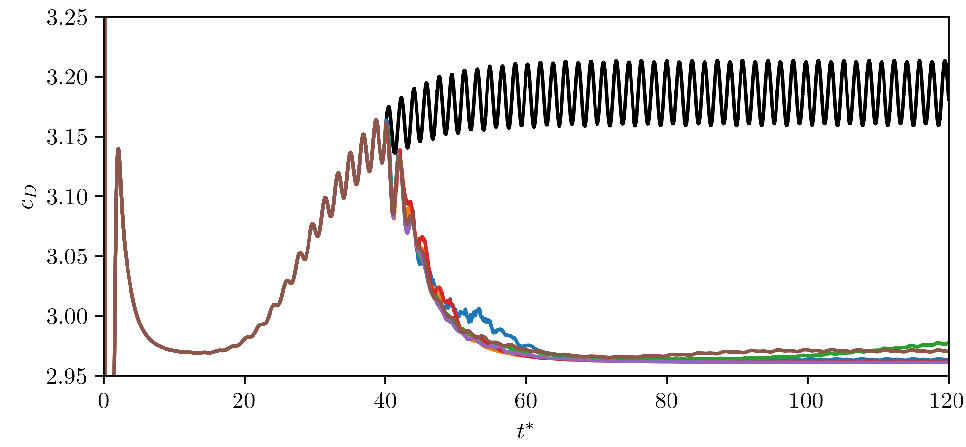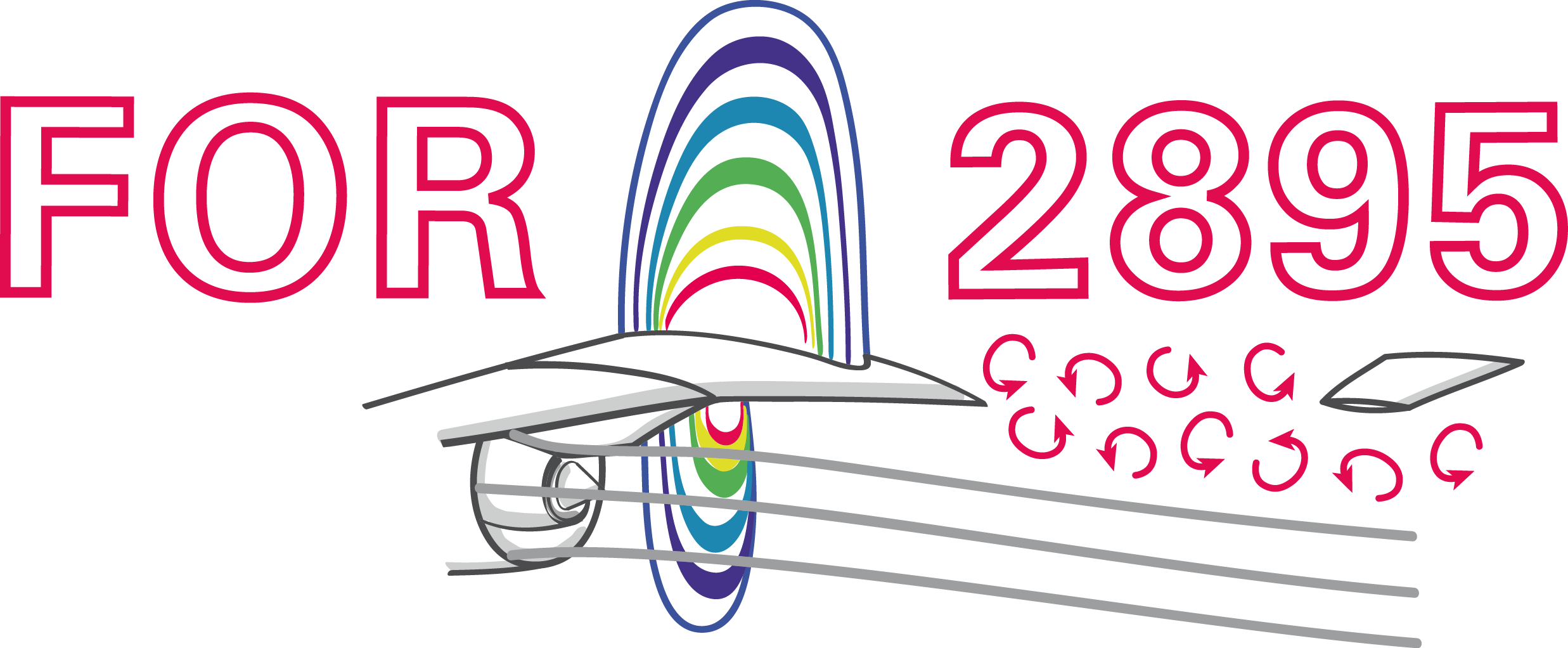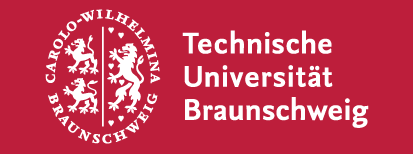Setting up a RL problem from scratch with drlfoam
Andre Weiner, Tomislav Maric
TU Braunschweig, Institute of Fluid
Mechanics
Outline
- closed-loop active flow control
- (deep) reinforcement learning
- setting up a flow control problem
- OF simulation
- OF boundary condition
- drlFoam environment
- running a training
- what's next?
Closed-loop active flow control
Goals of flow control:
- drag reduction
- load reduction
- process intensification
- noise reduction
- ...
Categories of flow control:
- passive: geometry, fluid properties, ...
- active: blowing/suction, heating/cooling, ...
active: energy input vs. efficiency gain
Categories of active flow control:
- open-loop: actuation predefined
- closed-loop: actuation based on sensor input
How to find the control law?
Closed-loop flow control with variable Reynolds number; source: F. Gabriel 2021.
Why CFD-based DRL?
- save virtual environment
- prior optimization, e.g., sensor placement
deep reinforcement learning
Create an intelligent agent that learns to map states to actions such that expected returns are maximized.
$s_t$ - state $s$ at time $t$ (observation)
- velocity probes
- surface pressure probes
- temperature probes
- ...
$s$ should be low-dimensional
$a_t$ - action $a$ at time $t$
- angular velocity
- mass flux
- heat flux
- ...
$a$ should be low-dimensional
reward and reward function
$r=-c_d - 0.1 |c_l|$
$r_t$ - reward at time $t$
$c_d$, $c_l$ - drag and lift coefficient
experience tuple
$$ \left\{ s_t, a_t, r_{t+1}, s_{t+1}\right\} $$
trajectory
$ \left\{s_0, a_0, r_1, s_1\right\} $
$ \left\{s_1, a_1, r_2, s_3\right\} $
$\left\{ ...\right\} $
Long-term consequences:
$$ G_t = \sum\limits_{l=0}^{N_t-t} \gamma^l r_{t+l} $$
- $t$ - control time step
- $G_t$ - discounted return
- $\gamma$ - discount factor, typically $\gamma=0.99$
- $N_t$ - number of control steps
What to expect in a given state?
$$ L_V = \frac{1}{N_\tau N_t} \sum\limits_{\tau = 1}^{N_\tau}\sum\limits_{t = 1}^{N_t} \left( V(s_t^\tau) - G_t^\tau \right)^2 $$
- $\tau$ - trajectory (single simulation)
- $s_t$ - state/observation (pressure)
- $V$ - parametrized value function
- clipping not included
Was the selected action a good one?
$$\delta_t = R_t + \gamma V(s_{t+1}) - V(s_t) $$ $$ A_t^{GAE} = \sum\limits_{l=0}^{N_t-t} (\gamma \lambda)^l \delta_{t+l} $$
- $\delta_t$ - one-step advantage estimate
- $A_t^{GAE}$ - generalized advantage estimate
- $\lambda$ - smoothing parameter
Making good actions more likely:
$$ J_\pi = \frac{1}{N_\tau N_t} \sum\limits_{\tau = 1}^{N_\tau}\sum\limits_{t = 1}^{N_t} \left( \frac{\pi(a_t|s_t)}{\pi^{old}(a_t|s_t)} A^{GAE,\tau}_t\right) $$
- $\pi$ - current policy
- $\pi^{old}$ - old policy (previous episode)
- clipping and entropy not included
- $J_\pi$ is maximized
setting up a flow control problem

Cylinder benchmark case; $Re=100$.

Proximal policy optimization (PPO) workflow (GAE - generalized advantage estimate).
 github.com/OFDataCommittee/drlfoam
github.com/OFDataCommittee/drlfoam
3 steps to solve a new control problem
- OpenFOAM simulation
- boundary condition (C++)
- drlfoam Env (Python)
1. OF simulation
openfoam/test_cases/rotatingCylinder2D
inputs for control law
probes
{
type probes;
libs (sampling);
executeControl runTime;
executeInterval 0.01;
writeControl runTime;
writeInterval 0.01;
timeStart 4.0;
fields (p);
probeLocations
(
(0.3 0.15 0.005)
...
);
}
quantities defining control objective
forces
{
type forceCoeffs;
libs (forces);
executeControl runTime;
executeInterval 0.01;
writeControl runTime;
writeInterval 0.01;
timeStart 4.0;
patches
(
cylinder
);
coefficients (Cd Cl);
...
}
define how to run the simulation
- Allrun.pre
- Allrun
- Allclean
2. boundary condition
openfoam/src/agentRotatingWallVelocity
getting the state
if (timeToControl && update_omega_)
{
const volScalarField& p =
this->db().lookupObject<volScalarField>("p");
scalarField p_sample = probes_.sample(p);
...
}

Policy network predicts probability density function(s) for action(s).
Comparison of Gauss and Beta distribution.
getting the next action I
torch::Tensor features = torch::from_blob(
p_sample.data(), {1, p_sample.size()},
torch::TensorOptions().dtype(torch::kFloat64)
);
std::vector<torch::jit::IValue> policyFeatures{features};
torch::Tensor dist_parameters = policy_.forward(policyFeatures).toTensor();
scalar alpha = dist_parameters[0][0].item<double>();
scalar beta = dist_parameters[0][1].item<double>();
getting the next action II
std::gamma_distribution<double> distribution_1(alpha, 1.0);
std::gamma_distribution<double> distribution_2(beta, 1.0);
scalar omega_pre_scale;
if (train_)
{
// sample from Beta distribution during training
double number_1 = distribution_1(gen_);
double number_2 = distribution_2(gen_);
omega_pre_scale = number_1 / (number_1 + number_2);
}
else
{
// use expected (mean) angular velocity
omega_pre_scale = alpha / (alpha + beta);
}
// rescale to actionspace
omega_ = (omega_pre_scale - 0.5) * 2 * abs_omega_max_;
using the boundary condition in 0.org/U
cylinder
{
type agentRotatingWallVelocity;
origin (0.2 0.2 0.0);
axis (0 0 1);
policy "policy.pt";
probesDict "probes";
train true;
seed 0;
absOmegaMax 5.0;
value uniform (0 0 0);
}
drlfoam Env
drlfoam/environment/rotating_cylinder.py
some convenience functions
def _parse_forces(path: str) -> DataFrame:
forces = read_csv(path, sep="\t", comment="#",
header=None, names=["t", "cd", "cl"])
return forces
def _parse_probes(path: str, n_probes: int) -> DataFrame:
names = ["t"] + [f"p{i}" for i in range(n_probes)]
return read_csv(
path, header=None, names=names,
comment="#", delim_whitespace=True
)
derived class
class RotatingCylinder2D(Environment):
def __init__(self, r1: float = 3.0,
r2: float = 1.0, r3: float=0.1):
super(RotatingCylinder2D, self).__init__(
join(TESTCASE_PATH, "rotatingCylinder2D"),
"Allrun.pre", "Allrun", "Allclean", 2, 12, 1
)
...
def _reward(self, cd: pt.Tensor, cl: pt.Tensor) -> pt.Tensor:
return self._r1 - (self._r2 * cd + self._r3 * cl.abs())
...
running a training
how to run a training
- go to examples
- modify run_example.py
DEFAULT_CONFIG = {
"rotatingCylinder2D" : {
"policy_dict" : {
"n_layers": 2,
"n_neurons": 64,
"activation": pt.nn.functional.relu
},
"value_dict" : {
"n_layers": 2,
"n_neurons": 64,
"activation": pt.nn.functional.relu
}
}
...
config = SlurmConfig(
n_tasks=env.mpi_ranks,
n_nodes=1,
partition="queue-1",
time="03:00:00",
constraint="c5a.24xlarge",
modules=["openmpi/4.1.5"],
commands_pre=[
"source /fsx/OpenFOAM/OpenFOAM-v2206/etc/bashrc",\
"source /fsx/drlfoam_main/setup-env"
]
)
buffer = SlurmBuffer(training_path, ...)
#!/bin/bash
#SBATCH --job-name=train_cylinder
#SBATCH --ntasks=6
#SBATCH --output=%x_%j.out
#SBATCH --partition=queue-1
#SBATCH --constraint=c5a.24xlarge
source /fsx/OpenFOAM/OpenFOAM-v2206/etc/bashrc
source /fsx/drlfoam_main/setup-env
source /fsx/drlfoam_main/pydrl/bin/activate
python3 run_training.py -o first_training \
-i 100 -r 10 -b 10 -f 8 \
-e slurm &> log.first_training
evaluating a policy
- make a copy of
baseand clean up - copy
policy_trace_xxx.pt
to the new folder; name itpolicy.pt - set
train 0;in 0.org/U - adjust
timeStart ...;in system/ - execute
Allrun.pre

Comparison of controlled and uncontrolled drag coefficient.
Evaluation of final policy.
What's next?
more control problems
- turbulence modeling
- shape optimization
- linear solvers
- ...
more advanced DRL topics
$\rightarrow$ Advances in the application of reinforcement learning to flow control problems
Wed, 09:00-09:20, room 4H
data-driven modeling SIG meeting
Thu, 5:15-6:15 pm, room 4H
3rd OpenFOAM-ML hackathon (register)
Jul 24-26
thanks to
Darshan Thummar, Fabian Gabriel, Jan Erik Schulze, Tom Krogmann, Janis Geise
Ajay Navilarekal Rajgopal, Guilherme Lindner, Julian Bissantz, Morgan Kerhouant, Mosayeb Shams, Tomislav Marić
Neil Ashton
THE END
Thank you for you attention!

